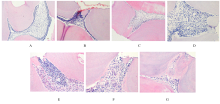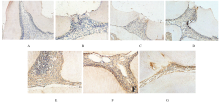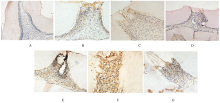| 1 |
BALLON ROMERO S S, LEE Y C, FUH L J, et al. Analgesic and neuroprotective effects of electroacupuncture in a dental pulp injury model-a basic research[J]. Int J Mol Sci, 2020, 21(7):2628.
|
| 2 |
ALBASHARI A, HE Y, ZHANG Y, et al. Thermosensitive bFGF-modified hydrogel with dental pulp stem cells on neuroinflammation of spinal cord injury[J]. ACS Omega, 2020, 5 (26): 16064-16075.
|
| 3 |
HOLAN G. Pulp Aspects of traumatic dental injuries in primary incisors: dark coronal discoloration[J]. Dent Traumatol, 2019, 35(6): 309-311.
|
| 4 |
YILMAZ M, KASNAK G, POLAT N G, et al. Pathogen profile and MMP-3 levels in areas with varied attachment loss in generalized aggressive and chronic periodontitis[J]. Cent Eur J Immunol, 2019, 44(4): 440-446.
|
| 5 |
MANKA S W, BIHAN D, FARNDALE R W. Structural studies of the MMP-3 interaction with triple-helical collagen introduce new roles for the enzyme in tissue remodelling[J]. Sci Rep, 2019,9(1):18785.
|
| 6 |
MATUSIEWICZ M, RACHWALIK M, KRZYSTEK-KORPACKA M, et al. Upregulated sulfatase and downregulated MMP-3 in thoracic aortic aneurysm[J]. Adv Clin Exp Med, 2020, 29(5): 565-572.
|
| 7 |
LU S, XIAO X, CHENG M. Matrine inhibits IL-1β-induced expression of matrix metalloproteinases by suppressing the activation of MAPK and NF-κB in human chondrocytes in vitro [J]. Int J Clin Exp Pathol, 2015, 8(5): 4764-4772.
|
| 8 |
DANIELS J T, GEERLING G, ALEXANDER R A, et al. Temporal and spatial expression of matrix metalloproteinases during wound healing of human corneal tissue[J]. Exp Eye Res, 2003, 77(6): 653-664.
|
| 9 |
赵荣欣,黄进华.基质金属蛋白酶在组织创伤愈合中的作用[J].中国美容医学,2013, 22(10): 1121-1123.
|
| 10 |
HOSHIJIMA M , HATTORI T , AOYAMA E, et al. Roles of interaction between CCN2 and Rab14 in aggrecan production by chondrocytes[J]. Int J Mol Sci, 2020, 21(8): 2769.
|
| 11 |
NISHIDA T, KUBOTA S, YOKOI H, et al. Roles of matricellular CCN2 deposited by osteocytes in osteoclastogenesis and osteoblast differentiation[J]. Sci Rep, 2019, 9(1): 10913.
|
| 12 |
LEASK A. CCN2 in skin fibrosis[J]. Methods Mol Biol, 2017, 1489:417-421.
|
| 13 |
QIU Y, TANG J, SAITO T. The in vitro effects of CCN2 on odontoblast-like cells[J]. Arch Oral Biol, 2018, 94:54-61.
|
| 14 |
HENDESI H, BARBE M F, SAFADI F F, et al. Integrin mediated adhesion of osteoblasts to connective tissue growth factor (CTGF/CCN2) induces cytoskeleton reorganization and cell differentiation[J]. PLoS One , 2015, 10(2): e0115325.
|
| 15 |
MUROMACHI K, KAMIO N, NARITA T, et al. MMP-3 provokes CTGF/CCN2 production independently of protease activity and dependently on dynamin-related endocytosis, which contributes to human dental pulp cell migration[J]. J Cell Biochem, 2012, 113(4): 1348-1358.
|
| 16 |
HANADA K, MOROTOMI T, WASHIO A,et al. In vitro and in vivo effects of a novel bioactive glass-based cement used as a direct pulp capping agent[J]. J Biomed Mater Res B, 2019, 1(107): 161-168.
|
| 17 |
MASTROGIACOMOA S, GÜVENERBC N, DOU W, et al. A theranostic dental pulp capping agent with improved MRI and CT contrast and biological properties[J]. Acta Biomater, 2017, 62: 340-351.
|
| 18 |
PARISAY I, GHODDUSI J, FORGHANI M. A review on vital pulp therapy in primary teeth[J]. Iran Endod J, 2015, 10(1): 6-15.
|
| 19 |
DHILLON H, KAUSHIK M, SHARMA R. Regenerative endodontics-creating new horizons[J]. J Biomed Mater Res Park B Appl Biomater, 2016, 104(4):676-685
|
| 20 |
RECHENBERG D K, GALICIA J C,PETERS O A.Biological markers for pulpal inflammation: a systematic review[J]. PLoS One, 2016, 11(11):e0167289.
|
| 21 |
GONG T, HENG B C, LO E C, et al. Current advance and future prospects of tissue engineering approach to dentin/pulp regenerative therapy [J]. Stem Cells Int, 2016,2016:9204574.
|
| 22 |
ALMALKI S G, AGRAWAL D K. Effects of matrix metalloproteinases on the fate of mesenchymal stem cells [J]. Stem Cell Res Ther, 2016, 7(1):129.
|
| 23 |
TAKIMOTO K, KAWASHIMA N, Suzuki N, et al. Down-regulation of flammatory mediator synthesis and in filtration of in flammatory cells by MMP-3 in experimentally induced rat pulpitis [J]. J Endod, 2014,40 (9):1404-1409.
|
 )
)









